The notion about protection zones of rod and catenary wire lightning rod is contained in the officially used Russian regulatory documents on lightning protection. Instructions on lightning protection of buildings, structures and industrial communications IS 153-34.21.122-2003 and Instruction on the lightning protecton of buildings and atructures AD 34.21.122-87" refer to them. National lightning protection standards strongly differ from those, introduced by IEM. The main difference lies in the fact that the top of the protection zone lies below the top of the lightning rod. The lower the object is located regarding the lightning rod, the more effectively it will be protected.
The fact, what value of lightning rod exceeding above the protected object lies in the dependence of the level of protection reliability from lightning, which should be provided by a lightning rod. In the regulations, used by designers in the RF, operate such notions, as a protection radius on the ground level and the value of lightning rod exceeding over the object. At that, the protection zone lies within the range of surface of a circular cone.
The peculiarities of protection zone calculation applied in the RF
Sizes of protectio zones used in the RF are counted with the help of a statistical method. With its help it is possible to define the expected number of breahtrhoughs to any number of structures. It can be a single building, or some part of it, or a complex of buildings.
If it is necessary to define the expected number of lightning breakthrough to some object, then only it should be studied as a protection object. The rest constructions of the system will be viewed as lightning rods. Building of typical protection zones was held for all types of lightning rods. Including double. The possibility of increasing the summary volume of protection zones at the group action of lightning rods is fully reflected.
Calculated formula in the Russian design can be used for lightnng rods, the height of which lies within 150 meters. EIC standards prescribe to only use lightning rods with the height of up to 60 m.
It is necessary to pay attention to some difference of caculation formula regarding protection zones sizes given in AD 34.21.122-87 and IS-153-34.21.122-2003 which was accepted 5 years ago. In particular, at the calculation given by formula, offered in the instruction of the year 1987, the value of protection radius of a rod lightning rod 30 m high for two zones, located on the ground level, will br 45 and 31,5 meters. At the same time, similar calculations with the same data, given in formula 2003 will give 24 and 36 meters.
The existing permission to use any of these regulatory documents when designing lightning protection can be explained by the fact, that both these documents are responsible for completely different probabilities of a lightning breakthrough. This way, it is possible to use both authorizing documents on lightning protection at the design, in order to have a possibility to choose optimal protection reliability for a certain case.
After holding a great number of experiments it was fixed that the electric puncture can happen not only on the shortest air interval but on any of it. The range of values of sparking voltages is subject to the law of Gauss (normal law) and is within certain limits.

Here U1 and U2 are average values of sparking voltage with the standards of range of σ1, σ2 and ∆Uр21 is their difference, which is also subject to a normal law. Scatter standard σ∆U is determined as

The probability of a breaktrough of a certain interval Ф1 can be executed by a tabulated integral of probability.

here

At the output of the formula presented here, the probability theory was used. It means, they can be used for the estimation of probability of any pair of events. Providing they won't happen without a dependence from each other. And completion of one event is an obligatgory condition for non-completion of another. The presence of a possibility of covering not only the shortest interval, but any of it is also considered.
Below you will see the main positions of the statistical method:
- At the elecrization of thunder clouds, there is a powerful electric field inside a cloud. A lightning itself is nothing different than an electric spark, which is intially formed in a cloud without any effects on it from the side of the ground and structures built on it. However, it dosn't happen all the time, but only until the head of the lightning channel achieves some distance above the ground. This distance is called height of orientation. It is noted as Ho. Lightning can be on absolutely any height and in any space with the similar probability.
- Descending to some level, Ho, lightning channel head starts the processof orientation in space. The direction of lightning becomes clear during this process. It can be directed to the ground surface or to the lightning rod, installed on some building. Since these are completely different directions of lightning, then formation of the plasma channel happens differently and absolutely independently from each other. In order to describe the probability of fulfilling these events in a mathematical way, the formula presented above are applied.
- Due to a great length of discharge gaps, the values of sparking voltages for them were taken as average Eпр. This way, it was possible not to use certain values of sparking voltages. Instead of them, only geometrical sizes of discharge gaps to the ground surface and to the top point of the lightning rod having some height h are used.

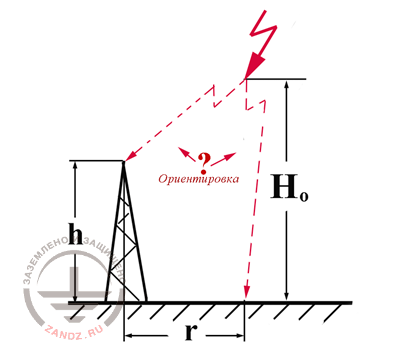
The orientation probability can be presented as the probability integral
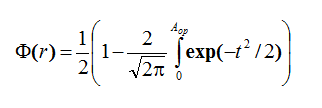
- As already mentioned, the strike point on the surface of lightning rod and the protected object is chosen occasionally. It happens in the following way: Loosing contact with a thunder cloud, the lightning starts is movement. The trajectory of this movement cannot be forecasted.
- The lightning strike point is defined as the result of orientation and choice which are independent events. During the orientation, it is defined how lighting will move in direction to the lightning rod, not to the ground surface. At the choice, the probability of the fact if the lightning strikes the object and won't be captured by a lightning rod, is determined.
- The lightning strike point is defined as the result of orientation and choice which are independent events. During the orientation, it is defined how lighting will move in direction to the lightning rod, not to the ground surface. At the choice, the probability of the fact if the lightning strikes the object and won't be captured by a lightning rod, is determined.
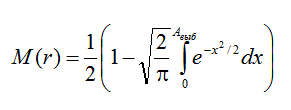

here

Is the shortest distance from the head of the lightning channel at the orientation height to the top of the lightning rod, the height of which is equal to hm;

Probability of a lightning breakthrough

In order to define the number of breakthroughs, it is necessary to integrate F(r) along the whole surface of orientation. Then this result shall be multiplied by value of relative density of thunder strikes in this area nm
A similar algorithm of calculation can be applied at any number of lightning strikes and protected objects regardless of their height, shape and sizes. If to suppose, that M=0, it is possible to count the complete number of lightning breakthroughs. Besides, it is possible to estimate the probability of a lightning breakthrough to the object.
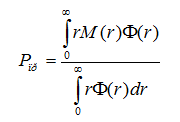
This calculation algorithm has geometrical sizes of the buildings located on the ground, and also the height of orientation and value of σ scatter standard. The height of orientation doesn't depend on the value of the charge transported by lightning. At the present time, there are no statistical data regarding lightning strikes of different force over the on-ground structures. That is why, it is impossible to correlate the height of the lightning orientation with the current strength. Average values of orientation height can be estimated coming out from the average value of lightning contraction radius Ratt. At the height h of the protected object Ratt= 3h. In this case, the orientation height
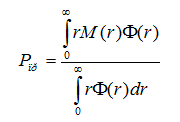
We get Ho= 5h. Relative value σ ≈ 0,1 was recieved during laboratory experiments with the intervals of great length. There is no reason to achieve a more precise value as this parameter doesn't have strong influence on the calculation results.
The material was created on the basis of an article by Professor Eduard Meerovich Bazelyan "Selection of lightning rods in the IEC standard".
See also:
- Useful materials for grounding and lightning protection designers (articles, manuals, guidelines)
- Design of grounding and lightning protection (projects in DWG and PDF formats)
- Webinars for designers and electricians with the leading experts
- Become a partner and join the ZANDZ.com Club of Experts
- Equipment for grounding and lightning protection
Related Articles:
 6. How to do that?
6. How to do that?

